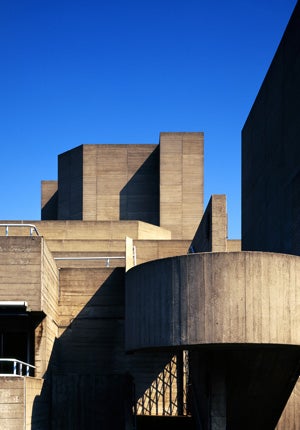£50m facelift planned for National Theatre

it is fair to say that not everyone was a fan of the new National Theatre building when it opened in 1976.
The Brutalist concrete monument to the publicly-funded arts was famously damned by the Prince of Wales who described it as a "clever way of building a nuclear power station in the middle of London without anyone complaining". The Economist, never an ideological bedfellow of the project, bemoaned it as a "cultural concentration camp", its stratified grey decks evoking the spirit of "an aircraft carrier in collision with a Norman keep".
By the time of the Millennium however, Denys Lasdun's controversial structure had won over the hearts and minds of the British public, who had come to regard its concrete walls with such affection that it was voted the fourth most-loved building in a BBC poll.
Later this summer, the National Theatre will submit a planning application for what is being billed as the most important redevelopment in its short history when it seeks approval for a £50m facelift for its Grade 2-star listed home. It is hoped the work will exploit the building's spectacular position adjoining the South Bank riverwalk – now one of the busiest thoroughfares in London – and help it reach out to the 12 million passers-by who stroll past it each year.
Assuming Lambeth Council gives the go-ahead, work is due to start by early 2012, provided of course that the money can be raised in one of the toughest economic situations since construction began. Theatre fundraisers have already staged early talks with charitable foundations and wealthy individuals but it looks likely it will be required to call on the public purse.
The new masterplan, which was the subject of a 48-hour public consultation earlier this month at the Theatre, will restore Lasdun's original orientation and create greater "transparency" to the public gaze from the Thames-side promenade. Architects Haworth Tompkins, who have already carried out refurbishment at the Young Vic and the Royal Court, have been appointed to perform the task.
National Theatre director, Nicholas Hytner, said the work was in keeping with the original ethos of bringing culture to the masses enshrined in the original National Theatre and the 1948 act of Parliament which brought it about. He said the new look would reflect the changing city and its people. "When the masterplan is complete we want to say – as the NT did when it first opened – the New National Theatre is yours," he said. "We're proud of our building and proud of the work we bring to our audiences. But if that work is to keep developing, then our building has to develop too," he added.
Project architect Paddy Dillon said puzzlement over why the service yard containing rubbish and recycling bins was located on the prime area on the side of the Thames was only resolved when the design team looked at some archive pictures taken before the pathway was built. Rather than catering for pedestrians the original design was based on welcoming visitors arriving by car. "That seemed fine at the time but there have been enormous changes in context. It's now London's prime highway: it beggars belief that 12 million people a year walk past the service yard," said Mr Dillon.
Instead the bins will be relocated to the back of the building, allowing the north-east corner to be opened up to the public for the first time.
The entrance will be reconfigured to make it more in keeping with Lasdun's original scheme, allowing a more natural flow into the refurbished foyers. There will be new cafes with outside seating and the Cottesloe theatre foyer will be enlarged and refurbished.
Fact file: Denys Lasdun
Inspired by the work of Le Corbusier, Denys Lasdun created some of post-war Britain's most controversial buildings.
In the 1980s he endured the full force of the backlash against the "carbuncles" he helped pioneer. Yet he lived to see fashion swing unexpectedly back in his favour and many of the structures derided by traditionalists when they arose amid London's Georgian terraces from the rubble left behind by the Luftwaffe or to accommodate the expansion of our universities were garlanded with listed status and marked down as masterpieces.
Keeling House in Bethnal Green, completed in 1955, for example, was abandoned by council tenants in 1992 because no one wanted to live there. The following year it was preserved and is now a thriving luxury apartment block. Lasdun's core buildings at the University of East Anglia with their uncompromising configuration of ziggurats set the standard for new academic construction in the 1960s.
Another masterpiece came in the form of the similarly battleship-like Institute of Education in Bloomsbury. But while his work was never loved by the Prince of Wales, another modernist-hater, Sir John Betjeman, held his most famous building, the National Theatre, in high esteem.
Supporters had dreamed of establishing a National Theatre in Britain since 1848 and the commission was to prove the biggest and most challenging of Lasdun's long career. He spent 18 months debating with its first artist director Laurence Olivier, as well as Peter Brook and Peter Hall, on the design of the auditorium and was required to contend with a dramatic change of brief when the original plan to include an opera house was cancelled by Prime Minister Harold Wilson. In the end it took 12 years to build. Lasdun was knighted in 1976 – the year the theatre was officially opened.
Join our commenting forum
Join thought-provoking conversations, follow other Independent readers and see their replies
Comments